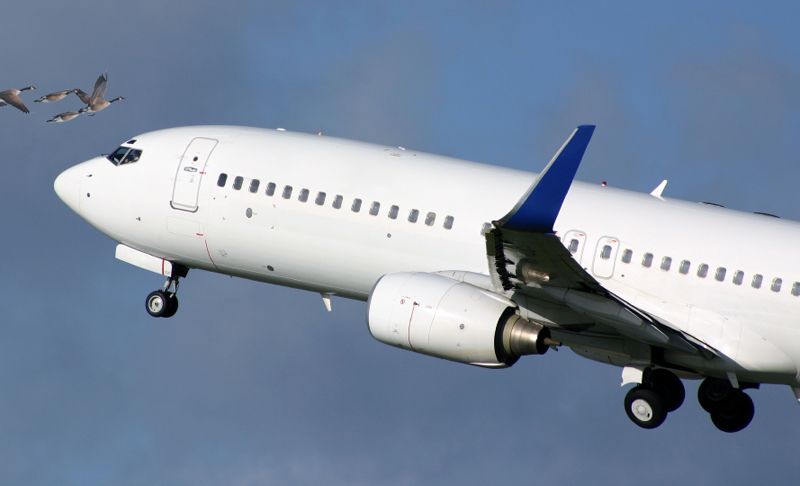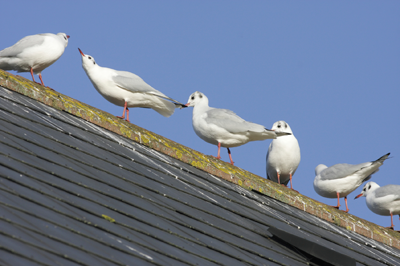
by Alex A. Kecskes
Birds have cost airlines big money in aircraft damage, downtime and even downed aircraft. The statistics are staggering and point to the need for aggressive bird control measures.
During a 19-year period from 1990 to 2008, 89,727 strikes were reported to the FAA across the United States. California, Texas, Florida, and New York suffered the most bird strikes (7,442, 5,963, 5,571 and 4,732, respectively). Twenty-one other states each reported more than 1,000 bird strikes.
While other wildlife sometimes contributed to aircraft mishaps, birds were involved in 97.4 percent of the reported strikes. Most
bird strikes occurred between July and October and 62 percent occurred during the day. A total of 60 percent occurred during an aircraft's landing, and 37 percent occurred during takeoff and climb. About 59 percent of the bird strikes occurred when the aircraft was at a height of 100 feet or less. Nearly 72 percent occurred at 500 feet or less and 92 percent occurred at or below 3,000 feet.
Bird control measures could have prevented many of the strikes.
A total of 59,047 bird strikes did not damage the aircraft; while 5,112 aircraft suffered minor damage; 2,456 suffered substantial damage; and 24 aircraft were destroyed as a result of the strike. The aircraft components most struck by birds were the nose/radome, windshield, engine, wing/rotor, and fuselage. Aircraft engines were most frequently damaged by
bird strikes.
For the 19-year period, five of the strikes resulting in seven fatalities involved unidentified species of birds. American white pelicans, Canada geese, white-tailed deer and brown-pelicans were responsible for nine fatalities. Ducks and geese caused 40 strikes, injuring 45 humans; vultures created 24 strikes, resulting in 26 injuries.
In April 2008, a Challenger 600 struck several American white pelicans at 3,000 feet during its climb from a Colorado airport. One bird penetrated the nose of the aircraft and entered the cockpit. Both engines ingested birds and one engine lost power. Fortunately, the pilot was able to return and land safely. Repair costs exceeded $2 million. Effective
bird control measures might have prevented this mishap.
In December 2008, a gadwall was ingested into the #3 engine of an MD-10 at 2,700 feet during the aircraft's approach. The entire engine and cowling had to be replaced. The aircraft was out of service for over three days and repair costs exceeded $900,000.
Effective Bird Control Measures
To prevent these and other bird strike mishaps, airports need to adopt effective and humane bird control measures. The most popular are listed below:
Bird Netting
A highly effective physical barrier method of bird control,
Bird Netting keeps pest birds from gathering and nesting at airport facilities. For best results, heavy-duty bird netting should be used. The best netting is made of ISO 1806 mesh test polyethylene fabric and is UV stabilized, flame resistant and rot and waterproof. Bird netting comes in various mesh sizes to deter specific bird species.
When covering an airplane hangar with bird netting, thousands of square feet of netting and special lifts and power equipment will be required. In this case, it's best to call in a
professional bird control installer. Improperly installed netting will sag and droop, creating gaps that allow pest birds to enter.
Misters and Foggers
Bird misters and foggers have been widely used at airports to achieve bird control. These devices emit an ultra fine mist of methyl anthranilate--a grape extract that naturally occurs in concord grapes--to disperse and discourage pest birds from gathering around tarmacs and runways. Recognized by the FDA as a safe substance, the chemical can be used to deter a wide range of pest birds, including, sparrows, pigeons, starlings, crows, blackbirds and geese. The chemical works by irritating the trigeminal nerve and mucous membranes of birds when they fly through it. One whiff and they're gone.
Bird Slopes
Bird Slopes achieve
bird control by denying pest birds a landing zone. And if they can't land, they won't stay. Birds simply slide off these angled, slippery PVC panels no matter how many times they try to "get a grip." Suitable for eaves, ledges, beams and other 90-degree areas where pest birds tend to nest and roost, the panels install easily using glue, nails or screws. Bird slopes even come in different colors to blend in with an airport's décor.
Electric Tracks
For on-the-spot bird control, Electric Track bird repellers work quite well as a bird control measure. Mount them on ledges, rooftops, in and around airport structures and birds will disappear from those areas. They work by delivering a harmless electric shock that quickly discourages pest birds. The best electric tracks feature a low-profile flow-through design to keep water from damming up around them.
Bird Gels
This is another localized bird control measure that will keep pest birds off towers and other airport structures. Bird Gels are easy to apply using a standard caulking gun. The gel stays sticky and tacky for about six months--a surface birds hate to set foot on. Safe for birds (except swallows), gels are an ideal
bird deterrent for use on ledges, I-beams, parapet walls, conduit, pipes, and most flat or curved surfaces.
Bird Sonic Devices
Like most creatures, birds feel very uncomfortable when they hear the sounds of predators nearby.
Bird Sonic devices exploit this fear to the max, broadcasting a variety of predator calls and birds in distress over a wide area. Some devices emit the sound of Peregrine falcons defending their territory (a pigeon's natural enemy). Another sonic device aimed at starlings and seagulls blasts the sounds of predator hawks screeching and gulls under attack. One versatile device emits distress and predator calls for as many as 22 types of birds. In some cases, the sounds are amplified and broadcast through special generating units, covering up to 40 acres. These sonic units, used in open areas, are best used with other methods of bird control such as the misting devices.
Plastic bird spikes
Plastic bird spikes are a highly effective method of bird control for use around airports. The chief advantage they have over stainless steel spikes is that they are non-conductive and won't interfere with EM transmissions. This means they can be used where high frequency transmissions like radar and other flight transmissions are being generated.
Installed on air-traffic control towers, hangars and maintenance bays,
plastic bird spikes won't allow pest birds to land. They are especially effective in preventing large pest birds from landing on flat or curved surfaces. Birds like pigeons, crows, gulls, vultures and raptors.
Bird Strike Statistics Courtesy of U. S. Department Of Transportation, FAA Wildlife Strikes to Civil Aircraft in the U.S. 1990–2008 U. S. Department of Agriculture Animal & Plant Health Inspection Service, Wildlife Services.




 by Alex A. Kecskes
by Alex A. Kecskes